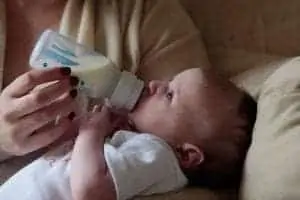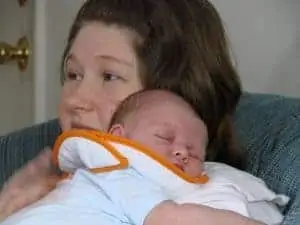Does your baby gulp his bottle down too fast and suffer from belly discomforts after feeding? If so, you need to try the paced bottle feeding method to slow down your baby’s eating habits.
Paced bottle feeding is a technique that is more common with breastfed babies who drink a bottle, but it’s beneficial for formula-fed babies as well. It helps slow down your baby’s feeding by keeping the bottle at a horizontal position rather than tilted up at an angle. This slows your baby’s feeding, reducing air intake, and helping your baby identify when fullness occurs.
If this sounds like something that your baby needs, here is everything you need to know about paced bottle feeding your infant.
What Is Paced Bottle Feeding?

Paced bottle feeding technique is a way to feed your baby, giving your infant control over the milk flow rather than the parent controlling the flow. It slows down the flow of milk that goes into the bottle nipple and the baby’s mouth so that your baby has to eat slower and take more breaks.
Paced feeding mimics breastfeeding; babies control the milk flow while breastfeeding and take more breaks while feeding. It reduces the intake of air while feeding, decreasing gassiness, belly aches, and acid reflux.
When you use this method, you reduce the risk of accidentally overfeeding your baby, which results in belly discomfort.
You can learn about breast-shaped bottles here.
Is Pace Feeding Necessary?
Pace feeding isn’t necessary, but it has benefits for all babies. Paced bottle-feeding for breastfed babies is normal because they are used to this flow, but formula-fed babies benefit from feeding slower as well.
Here are a few benefits of paced feeding
Your Baby Recognizes Fullness
Using this feeding method helps your baby learn to recognize that he is full when his belly feels full rather than the bottle being empty.
Adults do the same thing. When we’re starving, we eat food too fast, trying to fill our bellies. In the end, we feel miserable because our bellies hurt, and we overate.
Avoids Baby Being Over or Under Fed
When you feed your baby, it’s easy to give your baby the wrong amount of milk. You might overfeed your baby, leading to belly discomfort and gassiness. You also might underfeed your baby, causing growth and development problems.
Paced bottle feeding puts your baby in charge of his hunger and appetite.
It’s Less Stressful for Babies
Some babies find bottle feeding stressful rather than relaxing. They spend so much time trying to keep up with the flow of milk coming from the bottle. Babies often gulp or gag on the flow.
Paced feeding helps to create happy, relaxed associations with bottles. Your baby decides how much they need to eat and how fast he needs to eat.
Easier for Pumping Moms
Traditional bottle-feeding encourages babies to gulp the milk down, putting stress on pumping moms because they think they need to make more milk. They assume that they have a low milk supply when in reality, their babies ate too much.
Remember that:
When we let the babies control how much they eat, moms are more likely to notice that they pump the perfect amount for their babies. Babies don’t eat as much as we think they do!
Supports Breastfeeding
Breastfeeding is wonderful, but most mothers want to introduce a bottle. Whether to go to work or have a break, bottle feeding is often necessary, but some babies develop a bottle preference because the milk flow is faster.
If your baby becomes used to the faster flow from a bottle, he might start to prefer that over the breast. Using paced feeding is so similar to breastfeeding that it prevents this from happening.
The Steps for Paced Bottle Feeding
If you want to give this feeding method a try for your baby, here are the steps for paced bottle feeding,
- Pick a small bottle, typically one that is 4 ounces, and a slow flow nipple. It’s crucial to pick a slow-flow nipple for this technique.
- Grab your baby and hold him in your lap in a semi-upright position, being sure to support his neck and head. Use the nipple to tickle your baby’s lips to open, ensuring a wide latch.
- Hold the bottle flat – horizontal. This is the biggest difference when using slow-paced bottle feeding. Traditional bottle-feeding tells the parents to hold the bottle up at an angle.
- Let your baby feed, sucking on the nipple, tipping the bottle only enough that it’s halfway full of milk. Let your baby suckle for 20-30 seconds, then tip it back down to give your baby a break.
- Continue these steps until your baby shows signs of fullness. When your baby no longer sucks after the breaks, turns away, or pushes the nipple away, your baby is full.
You don’t have to continue to tip the bottle up and down for long. After a few days of using the paced bottle feeding method, your baby will naturally start to pace themselves and take breaks while feeding.
How Long Should Paced Bottle Feeding Take?
When you use the paced bottle feeding method, it takes 15-20 minutes to finish a bottle. Some babies start to pace themselves after using this method naturally. In general, the length of paced feeding should take the same amount of time as breastfeeding.
There is no set amount of time that your baby should take to empty a bottle. In the end, your baby should feel relaxed, settled, and content. He shouldn’t indicate any signs of hunger anymore.
Does Paced Bottle Feeding Cause Gas?
At first, you might wonder if paced bottle feeding leads to too much air being taken in a while feeding. We know that taking in too much leads to gassiness, but paced feeding leads to fewer gas problems.
If you notice too much gas, you might need to switch to a breast-shaped nipple and use a slower flow. It’s also a sign that you need to hold the bottle more horizontally to bring in less air while feeding.
Paced feeding leads to fewer gas problems than traditional bottle feeding because your baby doesn’t need to gulp to keep up with the milk flow. When babies gulp quickly, they take in more air, causing them to have gas and bellyaches.
Does Pace Feeding Help Reflux?
Yes, pace feeding helps babies who have reflux. When babies gulp milk and take in too much air, it presses on the stomach, pushing the acid back up their esophagus.
Another reason that pace feeding helps with reflux is that it prevents your baby from overheating. When babies eat too much, they’re more likely to spit up and have reflux. A slowed feeding also helps to prevent GERD and colic caused by immature digestive systems.
Final Thought
Paced bottle feeding is a great technique to use with babies. It helps your baby learn to understand his hunger and reduce overfeeding. If you want to give your breastfed baby a bottle, this method is highly encouraged and useful. Give it a try!
Hey, this is Linda. My biggest accomplishment in life is being a mother of four children. Their current ages range from almost ten years old down to 20 months old.
I’m passionate about writing parenting articles because I understand so well all of the problems and trials you face as a parent. From breastfeeding woes to budgeting problems and behavior problems, along with everything in between, chances are I’ve faced it over the last ten years. Read more about Linda here.






